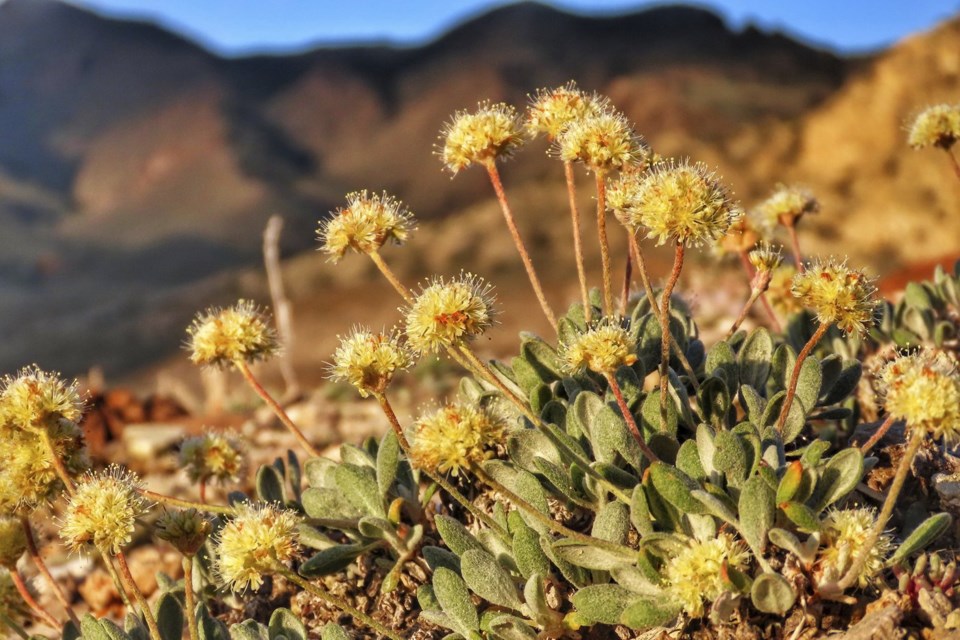RENO, Nev. (AP) — Conservationists and an advocacy group for Native Americans are suing the U.S. to try to block a Nevada lithium mine they say will drive an endangered desert wildflower to extinction, disrupt groundwater flows and threaten cultural resources.
The Center for Biological Diversity promised the court battle a week ago when the Ioneer Ltd.’s Rhyolite Ridge lithium-boron mine at the only place Tiehm's buckwheat is known to exist in the world, near the California line halfway between Reno and Las Vegas.
It is the latest in a series of legal fights over projects President Joe Biden’s administration is pushing under his intended to cut reliance on fossil fuels, in part by increasing the production of lithium to make electric vehicle batteries and solar panels.
The new lawsuit says the marks a dramatic about-face by nearly two years ago that Tiehm’s buckwheat was “in danger of extinction now” when they listed it as an endangered species in December 2022.
“One cannot save the planet from climate change while simultaneously destroying biodiversity,” said Fermina Stevens, director of the Western Shoshone Defense Project, which joined the center in the lawsuit filed Thursday in federal court in Reno.
“The use of minerals, whether for EVs or solar panels, does not justify this disregard for Indigenous cultural areas and keystone environmental laws,” said John Hadder, director of the Great Basin Resource Watch, another co-plaintiff.
Rita Henderson, spokeswoman for Interior's Bureau of Land Management in Reno, said Friday the agency had no immediate comment.
Ioneer Vice President Chad Yeftich said the Australia-based mining company intends to intervene on behalf of the U.S. and “vigorously defend” approval of the project, “which was based on its careful and thorough permitting process.”
“We are confident that the BLM will prevail,” Yeftich said. He added that he doesn't expect the lawsuit will postpone plans to begin construction next year.
The lawsuit says the mine will harm sites sacred to the Western Shoshone people. That includes Cave Spring, a natural spring less than a mile (1.6 kilometers) away described as “a site of intergenerational transmission of cultural and spiritual knowledge."
But it centers on alleged violations of the Endangered Species Act. It details the Fish and Wildlife Service's departure from the dire picture it painted earlier of threats to the 6-inch-tall (15-centimeter-tall) wildflower with cream or yellow blooms bordering the open-pit mine Ioneer plans to dig three times as deep as the length of a football field.
The mine's permit anticipates up to one-fifth of the nearly 1.5 square miles (3.6 square kilometers) the agency designated as critical habitat surrounding the plants — home to various pollinators important to their survival — would be lost for decades, some permanently.
When proposing protection of the 910 acres (368 hectares) of , the service said "this unit is essential to the conservation and recovery of Tiehm’s buckwheat.” The agency formalized the designation when it listed the plant in December 2022, dismissing the alternative of less-stringent threatened status.
“We find that a threatened species status is not appropriate because the threats are severe and imminent, and Tiehm’s buckwheat is in danger of extinction now, as opposed to likely to become endangered in the future,” the agency concluded.
The lawsuit also discloses for the first time that the plant's population, numbering fewer than 30,000 in the government's latest estimates, has suffered additional losses since August that were not considered in the U.S. Fish and Wildlife Service's biological opinion.
The damage is similar to what the bureau concluded was caused by in a 2020 incident that reduced the population as much as 60%, the lawsuit says.
The Fish and Wildlife Service said in its August biological opinion that while the project “will result in the long-term disturbance (approximately 23 years) of 146 acres (59 hectares) of the plant community ... and the permanent loss of 45 acres (18 hectares), we do not expect the adverse effects to appreciably diminish the value of critical habitat as a whole.”
—â¶Ä”
Eds: This story has been corrected to show the Western Shoshone Defense Project is a Native American advocacy group, not a recognized tribe.
Scott Sonner, The Associated Press




